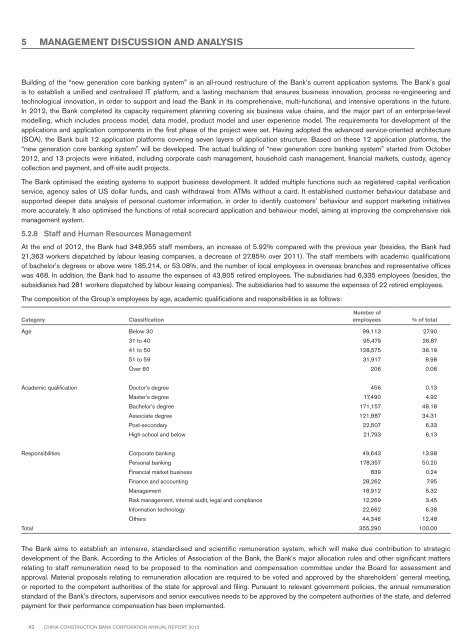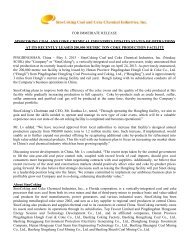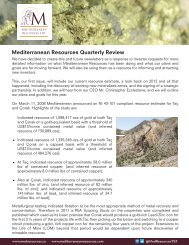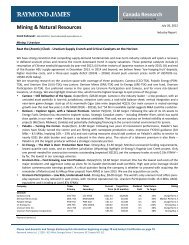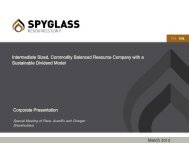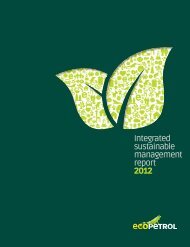5 MANAGEMENT DISCUSSION AND ANALYSISIn <strong>2012</strong>, the Bank innovatively launched a private banking version and e-accounts for its personal online banking system. It expanded lifeservices such as medical services and social insurance services, and developed new wealth management products such as personal foreignexchange trading and electronic savings bonds. Efforts were also made to develop online payment applications, and improve fundamentals suchas online customer service. A total of 60 batches of online wealth management products were issued during the year. The Bank successfullycompleted the integration of corporate online banking system for its domestic branches, and launched its overseas edition, which was in trialoperation in Hong Kong branch. The Bank launched a new client interface and “shake for account balance” service for its mobile phone bankingcustomers. It became the first among its peers to launch the sales of wealth management products via 2D scan codes, and issued 4 batchesduring the year. For SMS financial services, the Bank launched personal and automated customer services via SMS, as well as MultimediaMessage Service (MMS). The newly launched private banking online service consisted of seven models and hundreds of products and services,providing exclusive services for private banking clients, including wealth management reports, financial consulting specialists, self-service financialplanning, value-added services, information and periodicals. “Ehome.ccb.com”, a real estate property trading and financing service platform, wasintroduced, which provided a one-stop comprehensive service for real estate property transaction and housing loans, achieving a break-throughin the electronic service channel for personal loans. “E-Shangmaotong”, “Online Bids and Invitations”, “E-Dong Terminal”, and “SMS remittance”made it more convenient for the customers to do business with the Bank; “Joy Life” payment platform enabled the customers to make variouspayments and scenario application at home; “Student Benefit” provided multiple discounts specifically for college students.Feature article: E.ccb.com e-commerce platformOn 28 June <strong>2012</strong>, the Bank officially launched its e-commerce financial service platform – e.ccb.com. The platform provides corporate andretail customers engaging in e-commerce industry with professional services for release of product information, online transaction, paymentand settlement, installment plan, loan financing, fund custody, and real estate transactions. E.ccb.com focuses on cash flows, and promotesCCB’s strengths in payment and settlement, credit financing and other financial services, as a breakthrough in traditional banking operations.E.ccb.com consists of four sections, namely, e-commerce service, financial support service, operational management and risk management.E-commerce section mainly serves the customers that have electronic commercial needs, including corporate mall, retail mall, “ehome.ccb.com” and other services through electronic channel. Financial support service is to satisfy the financial needs of the independent e-commerceplatform and the members of the platform in the process of electronic commercial activities. The service mainly includes payment andsettlement service, fund custodial service, credit financing, credit card installment, and other innovative agency services such as investmentand wealth management agency services. E.ccb.com adopts a centralised operation model, and conducts market management, fundmanagement, credit underwriting and back office maintenance in a centralised manner. Based on CCB’s security structure and advancedfirewall technology, the platform established risk management mechanism for business operation at par with that for a financial institution,covering preventive controls, on-going monitoring and post-transaction solution.At the end of <strong>2012</strong>, e.ccb.com had more than one million members, and more than ten thousand internet merchants; transaction volume in thecorporate mall reached RMB3.5 billion, and the financing volume to merchants reached nearly RMB1 billion.Going forward, e.ccb.com will continue to integrate the flows of information, fund and commodities, and try to satisfy the customers’ growingdiversified needs with the help of its strength in traditional financial service, and push the Bank’s businesses in payment and settlement,financing and deposit towards electronic channels.5.2.7 Information TechnologyIn <strong>2012</strong>, the Bank intensified its efforts to building a “new generation core banking system”, and optimised the existing system to meet therequirements of business development, while ensuring secure and stable operations.The Bank secured safe operations by clearly setting the responsibility to meet each safety target. It rigorously managed the production andmodification of the systems. Both the production of application systems and modification of infrastructures have achieved unprecedentedprogress in recent years. By promoting “macro-operation” model in operation and maintenance, the Bank attained intensive and standardisedoperation. The operational efficiency reached a higher level as a result. In addition, the Bank enhanced risk controls over its electronic bankingchannel, improving its risk control capabilities in the area of information system. The availability rate of key systems such as the core bankingsystem reached 99.99% or above.China Construction Bank Corporation annual report <strong>2012</strong>41
5 MANAGEMENT DISCUSSION AND ANALYSISBuilding of the “new generation core banking system” is an all-round restructure of the Bank’s current application systems. The Bank’s goalis to establish a unified and centralised IT platform, and a lasting mechanism that ensures business innovation, process re-engineering andtechnological innovation, in order to support and lead the Bank in its comprehensive, multi-functional, and intensive operations in the future.In <strong>2012</strong>, the Bank completed its capacity requirement planning covering six business value chains, and the major part of an enterprise-levelmodelling, which includes process model, data model, product model and user experience model. The requirements for development of theapplications and application components in the first phase of the project were set. Having adopted the advanced service-oriented architecture(SOA), the Bank built 12 application platforms covering seven layers of application structure. Based on these 12 application platforms, the“new generation core banking system” will be developed. The actual building of “new generation core banking system” started from October<strong>2012</strong>, and 13 projects were initiated, including corporate cash management, household cash management, financial markets, custody, agencycollection and payment, and off-site audit projects.The Bank optimised the existing systems to support business development. It added multiple functions such as registered capital verificationservice, agency sales of US dollar funds, and cash withdrawal from ATMs without a card. It established customer behaviour database andsupported deeper data analysis of personal customer information, in order to identify customers’ behaviour and support marketing initiativesmore accurately. It also optimised the functions of retail scorecard application and behaviour model, aiming at improving the comprehensive riskmanagement system.5.2.8 Staff and Human Resources ManagementAt the end of <strong>2012</strong>, the Bank had 348,955 staff members, an increase of 5.92% compared with the previous year (besides, the Bank had21,363 workers dispatched by labour leasing companies, a decrease of 27.85% over 2011). The staff members with academic qualificationsof bachelor’s degrees or above were 185,214, or 53.08%, and the number of local employees in overseas branches and representative officeswas 468. In addition, the Bank had to assume the expenses of 43,805 retired employees. The subsidiaries had 6,335 employees (besides, thesubsidiaries had 281 workers dispatched by labour leasing companies). The subsidiaries had to assume the expenses of 22 retired employees.The composition of the Group’s employees by age, academic qualifications and responsibilities is as follows:CategoryClassificationNumber ofemployees% of totalAge Below 30 99,113 27.9031 to 40 95,479 26.8741 to 50 128,575 36.1951 to 59 31,917 8.98Over 60 206 0.06Academic qualification Doctor’s degree 456 0.13Master’s degree 17,490 4.92Bachelor’s degree 171,157 48.18Associate degree 121,887 34.31Post-secondary 22,507 6.33High school and below 21,793 6.13Responsibilities Corporate banking 49,643 13.98Personal banking 178,357 50.20Financial market business 839 0.24Finance and accounting 28,262 7.95Management 18,912 5.32Risk management, internal audit, legal and compliance 12,269 3.45Information technology 22,662 6.38Others 44,346 12.48Total 355,290 100.00The Bank aims to establish an intensive, standardised and scientific remuneration system, which will make due contribution to strategicdevelopment of the Bank. According to the Articles of Association of the Bank, the Bank’s major allocation rules and other significant mattersrelating to staff remuneration need to be proposed to the nomination and compensation committee under the Board for assessment andapproval. Material proposals relating to remuneration allocation are required to be voted and approved by the shareholders’ general meeting,or reported to the competent authorities of the state for approval and filing. Pursuant to relevant government policies, the annual remunerationstandard of the Bank’s directors, supervisors and senior executives needs to be approved by the competent authorities of the state, and deferredpayment for their performance compensation has been implemented.42 China Construction Bank Corporation annual report <strong>2012</strong>


